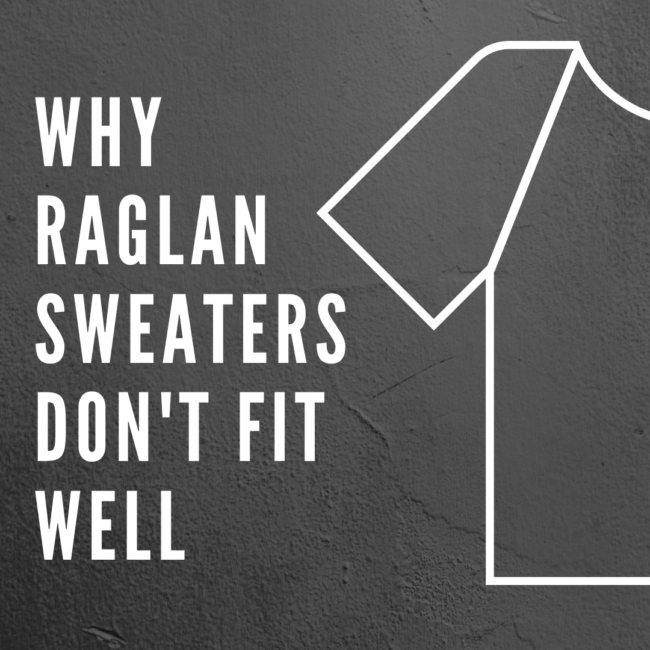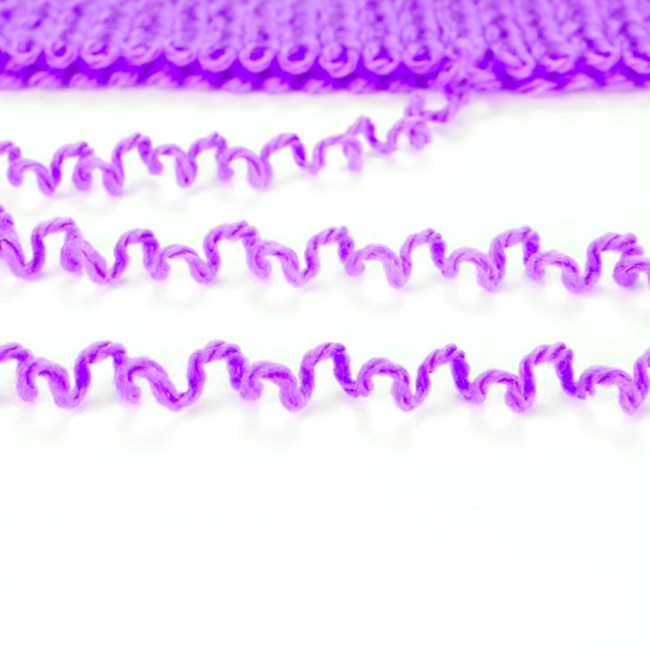
This post contains affiliate links. If you make a purchase following a link, I’ll receive a small commission. Thank you for the support!
Have you ever knit a raglan sweater that just didn’t fit, even if you met gauge? Maybe you had a raglan cardigan that kept falling off your shoulders? Or maybe it was a pullover that had extra fabric in the armpits? Why does this happen? What’s the solution? And how do you find patterns with these solutions in them?
The Basic Top Down Seamless Raglan Structure Explained
Top-down seamless raglan sweaters start with the neckline and typically have 8 – 10 increase locations depending on the sweater’s neckline and whether it is a pullover or a cardigan.

For a basic raglan crew neck pullover, the entire neckline will be cast on/chained and joined in the round with 8 increased locations. These increased locations are placed on both sides of a center seam at the edge of the sleeve stitches.

For a V neck shape the beginning cast on/chain is worked flat for a few rows and there are additional increases placed along the outer edges of the front panel. This is also how top-down seamless raglan cardigans are shaped until their desired front width.
The consistent rate of increases stacked on top of each other at the edges of the sleeves creates four straight seamlike lines running from the neckline to the underarm at the point at which the sleeve stitches are separated from the body. This is typically at the end of the yoke when the design reaches its full bust measurement.
The Problems
While this construction is very simple to create and easy to follow it can create some problems for a proper fit.
1. Equally Dimensioned on the Front and Back
The constant rate of increases assumes that the upper body circumference increases equally in the front and back. If your cross-back measurement is close to half your full bust circumference then this shape will fit you just fine, but if your cross-back measurement is less than half of your full bust circumference, then this sweater will not fit you well at all. The larger a women’s full bust circumference in comparison to her upper bust circumference, the more unflattering the fit. For example, if a woman with a large difference between their upper bust measurement and their full bust measurement makes the size to their full bust measurement then they will have too much fabric in the back of their sweater as well as their underarm. If they only knit to their upper bust measurement instead the sweater will be tight in the armpits and will not fit their full bust without additional alterations.
An equally dimensioned front and back also creates a problem for how the neckline sits on the shoulders. There is a natural curve to the top of your back shoulders and without the extra rows on the back to account for that curve the neckline may sit awkwardly or be uncomfortable.
2. Poor Armhole/Armscye Shaping

The armscye shaping on a topdown seamless raglan is a straight line that does not reflect the natural curve of the armpit like a typical set-in sleeve construction. This creates excess fabric where the armpit curves inwards. This is not as noticeable in raglan-style t-shirts made out of thin woven cotton fabric, but it is very noticeable when made using a worsted weight yarn or thicker.
This construction also lacks a seam at the top of the shoulder which helps keep the weight of the fabric from slipping off the shoulders which is a huge problem for raglan shaped cardigans.
The Solution
Adjust the Shaping
Patterns are designed based on measurement averages which means it’s already unlikely that it uses your exact measurements. It’s not unusual to have to do some pattern adjusting. Luckily modern pattern designers have come up with adjustments for seamless raglan shaping that offer a better fit.
5 Modern Raglan Adjustments
Here are five of the most common raglan adjustments that modern pattern designers use to create a better-fitting top-down seamless sweater.
1. Short Row Shaping at the Back Neck
To allow for a better fitting neckline on crew neck raglan pullovers, designers will add short row shaping along the back of the neck to raise the back above the front to account for the raised curved shape of the upper back shoulders. You can usually tell if a designer has made this adjustment by looking at the pattern’s photos. It is also often mentioned in the description of the pattern.
2. Knit/Crochet to the Upper Bust Measurement and Cast On/Chain Extra Underarm Stitches (Modified Raglan)

Knitting/crocheting to the upper bust measurement instead of the full bust eliminates the excess fabric in the inner curve of the armpit. To make sure the sweater will still fit the full bust measurement extra underarm stitches are added when separating the sleeves from the body. This massive increase at the underarm mimics the shape needed to contour the rapid outward curve of the lower armpit. This concept is explained in-depth and drawn out beautifully over on Tess Knits website. This adjustment is usually built into the pattern and can be a difficult adjustment to notice in a pattern unless the designer has described making this adjustment. Sometimes designers will describe this kind of adjustment as a modified raglan.
3. Change the Rate of Increases to Contour Body Curves (Compound Raglan)

Instead of a steady increase rate, the compound raglan starts off with a slower rate of increases at the top and slowly increases faster and faster closer to the end of the yoke. The increases stay stacked creating the iconic raglan line, but the changing rate of increases curves the line towards the underarm. This adjustment better mimics the shape of the armpit resulting in a better fit. You can find this adjustment made in raglan sweater designs described as compound raglans such as the Corinne Oval Pullover by Jennifer Wood. That pattern as well as several other sweaters using compound shaping can be found in Jennifer’s book Refined Knits.
4. Remove Early Sleeves Increases

This is another method that adjusts the traditional raglan’s even rate of increase. Instead of increasing the sleeves starting at the cast on/chain, increases are made on the front and back sections only, until a portion of the full length at the top of the shoulder has been reached. This shaping hugs the shoulder and provides a snug fit that helps keep raglan-shaped cardigans from falling off. This type of shaping can be seen in the Beekeeper Cardigan by Marie Greene. She describes it as “a unique saddle shoulder shaping that hugs your shoulders.”
5. Seamless Top Down Set In Sleeves – The Cocoknits Method

This method is taught in the Cocoknits Sweater Workshop by Julie Weisenberger and is a heavy modification of the traditional raglan. It is a top down seamless sweater with set-in sleeves. There is short row shaping to contour the upper back and tops of the shoulder. The pattern also uses a color-coded worksheet that helps you increase at the perfect rates to fit your body’s measurements. The Cocoknits Sweater Workshop book is full of sweaters designed by Julie Weisenberger that use this method.
How to Find Top Down Seamless Sweater Patterns That Will Fit Well
Adjusted raglan shaped sweaters are becoming more and more common. Here are some tips for finding better fitting seamless sweaters.
- Look to see if any adjustments are mentioned in the pattern’s description. Look for words such as “modified raglan” or “compound raglan”.
- Look for patterns described as top down and seamless that omit the word raglan, or that describe the shaping as something else like the description of “unique saddle shoulder shaping” in the Beekeeper Cardigan.
- Look at the pattern’s photos taking particular note of the fit on the neckline and the armpit.
- Look for pictures of the sweater being modeled on someone that has similar body measurements as you. Y
- Check the patterns schematic & measurements making note of the cross-back measurement if provided and compare that to the bust measurement.
- Ffollow any of the sweaters out of the Cocoknits Sweater Workshop book for a top-down seamless sweater that will fit your body like a glove.








